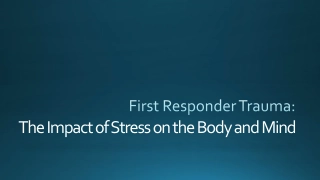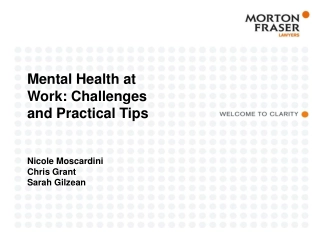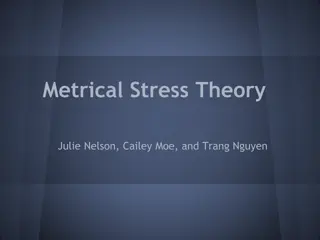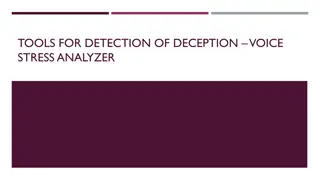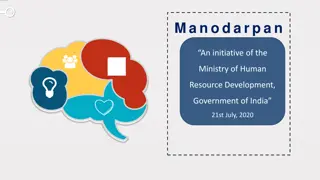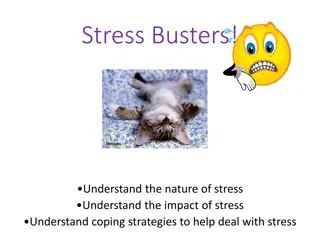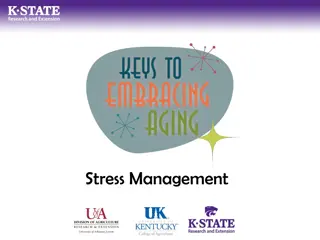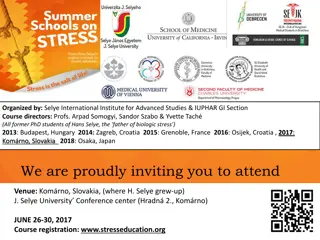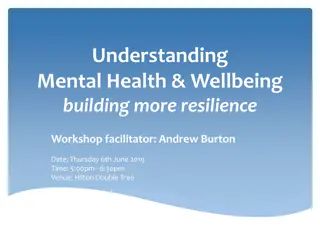Understanding Stress: Impact on Mental and Physical Health
Stress is a state of strain due to internal or external factors. It can manifest as acute or chronic, impacting physical, mental, and emotional health. Acute stress is short-term and manageable, while chronic stress is dangerous and hard to cope with. Eustress, a positive form of stress, can enhance performance, while distress leads to fear and poor performance. Recognizing the signs of stress and differentiating between types is crucial for managing its impact on well-being.
Download Presentation

Please find below an Image/Link to download the presentation.
The content on the website is provided AS IS for your information and personal use only. It may not be sold, licensed, or shared on other websites without obtaining consent from the author. Download presentation by click this link. If you encounter any issues during the download, it is possible that the publisher has removed the file from their server.
E N D
Presentation Transcript
Nicosia Area Control Center E. Symeonides Air Traffic Control Officer Safety Assessment Specialist Apr 2017
Stress A state of physical, mental or emotional strain (tension) due to some external or internal stimulus. Stressor Any activity, event or other stimulus that causes stress.
SITUATION HUMAN THREAT ? THREAT ? Adrenalin: FIGHT OR FLIGHT Cortisol, Serotonin
Acute Stress Chronic Stress Stressors occur for a short period of time. The individual is able to resolve the stressful situation and return to normal mental and psychological state. Symptoms Sweaty Palms Increased heart rate. Trembling Shortness of breath. Gastrointestinal distress. Muscle Tension. Caused by constant stream of demands, risks, pressures, for a long period of time. Drains mental and physical resources. Sense of hopelessness Inability to cope. Increased risk of cardiovascular diseases. Gastrointestinal problems. Sleep disorders. Stroke. Suicide.
Chronic Stress Hard to manage. Very dangerous. Acute Stress Manageable at the time or soon after the stressor.
Eustress allows a person to perform effectively and may even increase performance. Eustress generally occurs when an individual perceives that he or she has the ability to effectively cope with a stressor. Eustress (positive stress) (positive stress) motivates a person to cope with stressors and Distress causes fear of the situation, panic, anxiety or agitation. Distress usually results in poorer performance. Distress (negative stress) (negative stress) occurs when stimulation is excessive and Anxiety by the anticipation or perception that something dangerous, unpleasant or harmful may be about to occur, and the individual is fearful that he or she will not be able to cope with the event. Anxiety stress stress related to an unforeseen or imagined threat. It is caused Remembered Stress of a past experience that caused extreme stress or harm. The actual stress-causing agent may not be present, but the memory still causes the body to arouse the nervous system, and the stress related to the effects of the unpleasant episode are experienced again. Remembered Stress is triggered by an event that reminds an individual
Physical symptoms Physical symptoms Emotional symptoms Emotional symptoms Behavioral symptoms Behavioral symptoms Cognitive symptoms Cognitive symptoms Tense muscles, especially in the neck and shoulders Frustration, irritability or anger Abuse of alcohol, drugs or other substances Forgetfulness, preoccupation and difficulty concentrating Indecisiveness Headache or backache Depression or anxiety Marital problems Stomachache, nausea, vomiting, diarrhea or constipation Tiredness or difficulty sleeping Unusually rapid heartbeat Nervousness Binge eating Work mistakes and loss of productivity Boredom Self-destructive behavior Excessive worry Apathy Decrease in creativity Shakiness or excessive sweating Weight loss or weight gain Loss of sense of humor Clenched jaw or clenched teeth Fingernail-biting Sighing or changes in breathing patterns Decreased interest in sex
Physical (external) Noise Pollution Overcrowding Excess weather conditions Time pressure Performance standards Physical (internal) Pain Hunger Lack of sleep Exhaustion Threats to security and self-esteem.
Work related Pressure from the management to ensure on time performance (meet the deadlines). Pressure from the clients Work underload Work overload Colleague dealing with a stressful situation creates stress to those around him. Productivity Vs. Safety
LOW HIGH Positive Stress (motivation) Decision Latitude Low Strain Active Passive High Strain Negative Stress (Health problems) Job demands
Personal Financial problems Illness Injury Loss of a relative consumes mental resources and distracts a person from the task at hand. Preoccupation with personal problems Small stressors can add up over time and greatly affect people s performance.
100 90 80 70 60 50 40 30 20 10 0
Work Nature Complex set of tasks High levels of knowledge High sense of responsibility Expertise Practical application of skills Limited decision time
Six main activities can be identified Situation monitoring Resolving aircraft conflicts Sequencing Routing or planning flights Assessing wx impact. Managing sector position resources Include 46 sub 348 distinct tasks Six main activities can be identified Include 46 sub- -activities 348 distinct tasks activities
operations concepts, Vol. VI. AKTCC/HOST En route controllers, report number DOT/FAA/AP/86-01 operations concepts, Vol. VI. AKTCC/HOST En route controllers, report number DOT/FAA/AP/86-01 operations concepts, Vol. VI. AKTCC/HOST En route controllers, report number DOT/FAA/AP/86-01 H.L. Ammennan, L.J. Bergen, D.K. Davies, CM. Hostetler, E.E. Inman and G.W. Jones: FAA airtraffic control H.L. Ammennan, L.J. Bergen, D.K. Davies, CM. Hostetler, E.E. Inman and G.W. Jones: FAA air traffic control H.L. Ammennan, L.J. Bergen, D.K. Davies, CM. Hostetler, E.E. Inman and G.W. Jones: FAA air traffic control (Washington, Federal Aviation Administration, 1987). (Washington, Federal Aviation Administration, 1987). (Washington, Federal Aviation Administration, 1987). colleagues Lack of control over work process Salary Public opinion DEMAND Number of aircraft under control Peak traffic hours Extraneous Traffic Unforeseeable events DEMAND OPERATING PROCEDURES Time pressure Having to bend the rules Feeling loss of control Fear of consequences of error WORKING TIMES Unbroken duty periods Shift and night work WORKING TIMES WORKING TOOLS Limitations and reliability of equipment Layout / ergonomics WORKING TOOLS WORK ENVIRONMENT Lighting Noise Rest facilities Microclimate WORK ENVIRONMENT Lighting Noise Rest facilities Microclimate WORK ORGANIZAT ION Role ambiguity Relation with sups and WORK ORGANIZAT ION
Short term effects Brain and cardiac activity Hormonal excretion Performance efficiency Mental Process Operative behavior Short term effects Sources of stress Work demands Operating procedures Working times Working Tools Work environment Work Organization Sources of stress Depending on Personality traits Skills Aptitude Motivation Experience Operating behavior Copying strategies Social support Depending on Long term effects Hypertension Ischemic heart disease Diabetes Peptic ulcer Psychoneurotic disorders Long term effects
Recognize the potential signs and symptoms of stress Be proactive in removing the cause of stress (e.g. assign more priority to the short term conflict first before controlling other aircraft etc.) Removing yourself from the stressful situation by knowing one's own capabilities (e.g. calling out for help from colleagues if in a very complex ATC scenario) Prioritise actions Do not be over focused in finishing the mission at any cost and regardless of the situation Be current with all existing procedures at the workplace
Physical Factors Maintain good physical fitness Use relaxation techniques Have regular meals Have sufficient sleep Time management Control the physical environment Physical Factors
Psychological Factors Sound preparation with regard to knowledge, skills and procedures Building confidence in own training and ability Leading balanced social and family life Share and discuss problems so as not to bottle them up Solve problems as soon as possible to prevent the domino effect Psychological Factors
Stress Management in ATC, Skybrary Prof. Giovanni Costa, Occupational stress and stress prevention in Air Traffic Control EUROCONTROL, Human Factors Module Stress , 15.03.1996

 undefined
undefined


